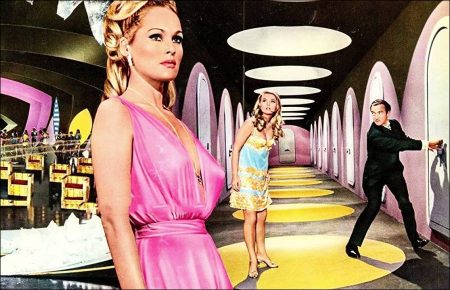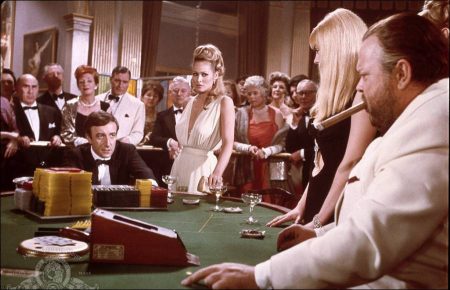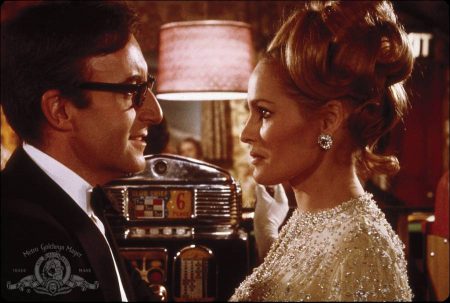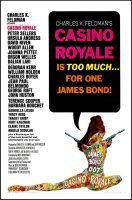Casino Royale movie storyline. An unofficial and secret cooperative of the heads of British/French/American/Soviet intelligence try to persuade the original Sir James Bond 007 – known to be the greatest spy in history – to come out of retirement to work on a specific case: discover and stop the unknown forces that are murdering their collective agents. The womanizer who took over Sir James’ name and number – who Sir James detests as sullying that good name and number by relying too much on gadgetry to get the work done – has moved onto other things, and Sir James’ nebbish nephew Jimmy Bond has proved to be a disappointment as a spy and a man, and thus are not candidates for the job.
Sir James politely declines, until a specific incident not only brings him out of retirement, but places him in the top job at MI6. Sir James eventually learns that it is SMERSH who is behind the murders. As such, Sir James amasses a team of agents all who are to named James Bond 007 – even the women – to confuse SMERSH. Among the ranks of new James Bond 007’s, each who his or own specific duty, are: Coop, who is irresistible to women but will be trained to deny those feelings in return, as it has been proved that the demise of most of the agents was due to falling prey to sex; the Detainer, a newly devised secret weapon in a truly feminine form.
Wealthy Vesper Lynd, a former agent whose main role is to be the recruiter and handler for the next Bond on the list; Evelyn Tremble, a baccarat master, who will challenge SMERSH’s financial agent, Le Chiffre, to a game at Casino Royale, this the primary means SMERSH is financed; and Mata Bond, Sir James and Mata Hara’s illegitimate daughter, a dancer who will infiltrate an au pair service in East Berlin known to be a front for SMERSH’s training center for their young, female operatives. Even if all the James Bond 007’s are able to carry out their roles successfully, Sir James and the team will still have to discover the mastermind within SMERSH and his/her specific motive for the agent murders.
Casino Royale is a 1967 spy comedy film originally produced by Columbia Pictures featuring an ensemble cast. It is loosely based on Ian Fleming’s first James Bond novel. The film stars David Niven as the “original” Bond, Sir James Bond 007. Forced out of retirement to investigate the deaths and disappearances of international spies, he soon battles the mysterious Dr. Noah and SMERSH.
The film’s tagline: “Casino Royale is too much… for one James Bond!” refers to Bond’s ruse to mislead SMERSH in which six other agents are pretending to be “James Bond”, namely, baccarat master Evelyn Tremble (Peter Sellers); millionaire spy Vesper Lynd (Ursula Andress); Bond’s secretary Miss Moneypenny (Barbara Bouchet); Bond’s daughter by Mata Hari, Mata Bond (Joanna Pettet); and British agents Coop (Terence Cooper) and The Detainer (Daliah Lavi).
Casino Royale was released on 13 April 1967, two months prior to Eon’s fifth Bond movie, You Only Live Twice. The film was a financial success, grossing over $41.7 million worldwide, and Burt Bacharach’s musical score was praised, earning him an Oscar nomination for the song “The Look of Love”. Critical reception to Casino Royale, however, was generally negative, with many reviewers regarding it as a baffling, disorganised affair. Since 1999, the film’s rights have been held by Metro-Goldwyn-Mayer, distributors of the official Bond movies by Eon Productions.
About the Production
The principal filming was carried out at Pinewood Studios, Shepperton Studios and Twickenham Studios in London. Extensive sequences also featured London, notably Trafalgar Square and the exterior of 10 Downing Street. Mereworth Castle in Kent was used as the home of Sir James Bond, which is blown up at the start of the film. Much of the filming for M’s Scottish castle was actually done on location in County Meath, Ireland, with Killeen Castle as the focus. However, the car chase sequences where Bond leaves the castle were shot in the Perthshire village of Killin with further sequences in Berkshire (specifically Old Windsor and Bracknell).
The production proved to be rather troubled, with five different directors helming different segments of the film and with stunt co-ordinator Richard Talmadge co-directing the final sequence. In addition to the credited writers, Woody Allen, Peter Sellers, Val Guest, Ben Hecht, Joseph Heller, Terry Southern, and Billy Wilder are all believed to have contributed to the screenplay to varying degrees. Val Guest was given the responsibility of splicing the various “chapters” together, and was offered the unique title of co-ordinating director but declined, claiming the chaotic plot would not reflect well on him if he were so credited. His extra credit was labelled ‘additional sequences’ instead.
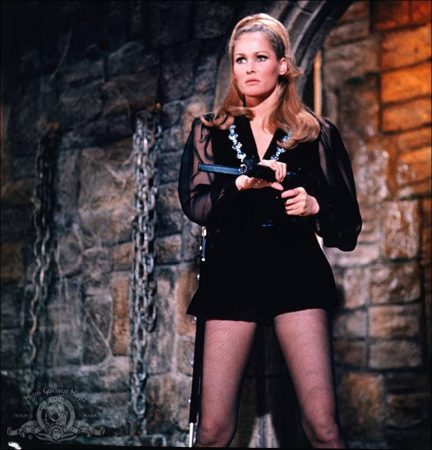
Part of the behind-the-scenes drama of this film’s production concerned the filming of the segments involving Peter Sellers. Screenwriter Wolf Mankowitz declared that Sellers felt intimidated by Orson Welles to the extent that, except for a couple of shots, neither was in the studio simultaneously.
Other versions of the legend depict the drama stemming from Sellers being slighted, in favour of Welles, by Princess Margaret (whom Sellers knew) during her visit to the set. Welles also insisted on performing magic tricks as Le Chiffre, and the director obliged. Director Val Guest wrote that Welles did not think much of Sellers, and had refused to work with “that amateur”. Director Joseph McGrath, a personal friend of Sellers, was punched by the actor when he complained about Sellers’s behaviour on the set.
Some biographies of Sellers suggest that he took the role of Bond to heart, and was annoyed at the decision to make Casino Royale a comedy, as he wanted to play Bond straight. This is illustrated in somewhat fictionalised form in the film The Life and Death of Peter Sellers, based on the biography by Roger Lewis, who has claimed that Sellers kept re-writing and improvising scenes to make them play seriously. This story is in agreement with the observation that the only parts of the film close to the book are the ones featuring Sellers and Welles. In the end, Sellers’s involvement with the film was cut abruptly short
Jean-Paul Belmondo and George Raft received major billing, even though each actor appears only briefly. Both appear during the climactic brawl at the end, Raft flipping his trademark coin and promptly shooting himself dead with a backward-firing pistol, while Belmondo appears wearing a fake moustache as the French Foreign Legion officer who requires an English phrase book to translate “merde!” into “ooch!” during his fistfight. Raft’s coin flip, which originally appeared in Scarface (1932), had been spoofed a few years earlier in Some Like It Hot (1959).
At the Intercon science fiction convention held in Slough in 1978, David Prowse commented on his part in this film, apparently his big-screen debut. He claimed that he was originally asked to play “Super Pooh”, a giant Winnie-the-Pooh in a superhero costume who attacks Tremble during the Torture of The Mind sequence. This idea, as with many others in the film’s script, was rapidly dropped, and Prowse was re-cast as a Frankenstein-type monster for the closing scenes. The final sequence was principally directed by former actor and stuntman Richard Talmadge.
Casino Royale (1967)
Directed by: Ken Hughes, John Huston, Joseph McGrath, Robert Parrish, Val Guest, Richard Talmadge
Starring: Peter Sellers, Ursula Andress, Barbara Bouchet, David Niven, Woody Allen, Joanna Pettet, Orson Welles, Daliah Lavi, Deborah Kerr, Charles Boyer, John Huston, Jean-Paul Belmondo, Kurt Kasznar, George Raft
Screenplay by: Wolf Mankowitz, John Law, Michael Sayers
Production Design by: Michael Stringer
Cinematography by: Jack Hildyard
Film Editing by: Bill Lenny
Costume Design by: Julie Harris, Anna Duse
Art Direction by: Ivor Beddoes, Lionel Couch, John Howell
Music by: Burt Bacharach
MPAA Rating: None.
Distributed by: Columbia Pictures
Release Date: April 13, 1967 (London), April 28, 1967 (New York)
Views: 484
